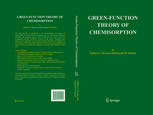

Most ebook files are in PDF format, so you can easily read them using various software such as Foxit Reader or directly on the Google Chrome browser.
Some ebook files are released by publishers in other formats such as .awz, .mobi, .epub, .fb2, etc. You may need to install specific software to read these formats on mobile/PC, such as Calibre.
Please read the tutorial at this link: https://ebookbell.com/faq
We offer FREE conversion to the popular formats you request; however, this may take some time. Therefore, right after payment, please email us, and we will try to provide the service as quickly as possible.
For some exceptional file formats or broken links (if any), please refrain from opening any disputes. Instead, email us first, and we will try to assist within a maximum of 6 hours.
EbookBell Team

5.0
100 reviewsThe book provides an introduction to the Green-Function (GF) theory of chemisorption. It is self-contained, and requires only a basic knowledge of quantum mechanics and solid-state physics. The GF approach lends itself well to the pedagogically desirable modellistic treatment of the subject. Throughout each chapter, step-by-step details are provided by which the calculations are performed, so that readers are led from the simple to the more advanced aspects, in a straightforward manner. In this way, students gain confidence to read the current literature on their own.
This book includes:
A straightforward introduction into Green-Function Theory of Chemisorption
The mathematical foundation of the Green Function Method
Electron- electron interaction on the adatom
Demonstration of the power and versatility of the technique
Metalized semiconductoe substrates as example of supported catalysts
Electronic properties of disordered binary alloys and treatment of chemisorption on such substrates
Chemisorption on electrified substrates
Implications of two atoms interacting with a substrate on adatom formation
Extensive Appendices
The book is suitable for Senior undergraduate and junior graduate students in theoretical and physical chemistry, students in catalysis, chemical engineering and materials science Researchers in government and industrial laboratories should also find the book useful.